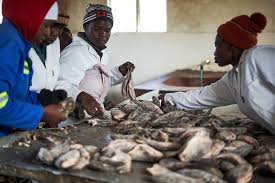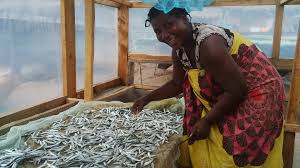Many of the problems and constraints encountered in handling, processing and marketing are common to both men and women. Limited access to resources, insufficient credit facilities, inadequate transport means, bad roads, poor processing and marketing facilities, price policies, etc., are all factors constraining the development of processing and trading of fish and fish products in the developing world.
Production policies and projects often ignore the role of processing and marketing. Interventions usually concentrate on modern enterprises and distribution to larger markets, instead of supporting individual or collective activities. Insufficient incentives and financial support will continue to constrain rural distribution systems.
Apart from the constraints common to both men and women, women often face an extra set of gender-specific problems. Domestic activities, limited time disposition, no title to land or cattle, and no access to credit, make women more disadvantaged compared with men.
An analysis of the role of women in the production, processing, and marketing sectors is often lacking in project planning. The introduction of a new production system or technology often ends up demanding more labour from women while allocating most of the benefits to men.
Project planners cannot foresee the risks and disincentives for women. Processing plants and markets have been constructed without prior consultation with the intended users. On many occasions the inappropriateness of new technologies and constructions could have been avoided if participatory development was pursued.
Small-scale processing and marketing is a competitive rather than a cooperative action. A spontaneous solidarity of women generating a communal enterprise to obtain credit and to protect themselves against other commercial traders is not to be expected.
Management Procedures

Women acquainted with fish processing and marketing readily include aquaculture products, especially if pond harvest coincides with the slack season in capture fisheries. It is imperative to regulate the distribution and marketing of perishable products like fish and shellfish. Instead of trying to introduce deliberate changes into the marketing systems which involve completely new roles for women, it is advisable to adapt local production and marketing patterns towards multi-functional trade associations.
Aquaculture products have to compete with traditional products. If aquaculture production is focused on a highly preferred product already available on the markets, it will have to compete through price. When new products are introduced, the customer often requires a period of
time to accept the new product. Consumer preferences for size, external features, taste, and price must all be taken into consideration.
Women’s participation in aquaculture is not taken into account by planners and policy-makers. A full understanding of the role of women as traders indicates their economic significance for the functioning and further development of aquaculture. Opportunities for women to discuss their constraints and opportunities can draw attention to the risks and disincentives not foreseen by project planners.
In extensive and semi-intensive aquaculture production systems, harvesting the pond is a communal activity and the fish are primarily destined for local consumption and marketing.
Women are actively involved in the handling of fish from small-scale production with local
transportation. Small-scale handling has been neglected by project planners. The handling of fish in extensive and semi-intensive systems needs more attention in the form of training, extension, and credit.
Particular attention is needed to improve quality control of fish to prevent deterioration during fish handling operations, and to develop more products for domestic consumption.
Processing of aquatic products is considered to be women’s work. Although most processing enterprises are run on an informal basis, their scale and way of operation makes these enterprises important for the employment and income generation of women.
Read Also: Post-Harvest Handling of Fish and Marketing
Inadequate analysis and neglect of these enterprises has often resulted in a disruption of the rural fish supply and the position of women. Support of small-scale processing is critically needed. The development and extension of appropriate fish preservation and processing technologies should be promoted. Training of women should be arranged in such a way that disruption of the daily work is avoided.
Intensive systems are capital intensive and their produce are primarily destined for urban centers where better prices can be obtained. Transport to urban centers requires sophisticated equipment and good roads. Women’s access to selling and transport is limited by lack of cash, transport, and market facilities. More attention to appropriate transportation services and marketing facilities at local markets can be of benefit to people and can reduce transportation costs.
Inadequate market facilities, such as lack of ice plants, containers with aerating devices, processing facilities, protected (cold) storage facilities, good roads, shelter, transport facilities, etc., often limit the development of trading enterprises. Strategies to overcome constraints for marketing would benefit both sellers and buyers. A seminar (FAO, 1977) on market women in West Africa gives the following recommendations:
(a) More attention to the role of traders in the formulation and development of policies,
(b) Development of appropriate technologies for food processing and preservation,
(c) Construction and maintenance of rural roads,
(d) Provision of transportation and spare parts,
(e) Promotion of the establishment of trade associations,
(f) Increase of credit facilities to traders by involving trade associations as guarantors for individual loans,
(g) Vocational training (bookkeeping, application forms for credit),
(h) Improvement and expansion of existing market facilities (storage, loading space for vehicles, shelter, childcare centers, health clinics),
(i) Provision of information by marketing advisory services,
(j) Supply of essential inputs for farms (fertilizers, seeds, etc.),
(k) Improvement of communication channels between traders, producers and relevant local extension agencies and government institutions.
Markets can be focal points for rural development. The better the market facilities, the more people are motivated to participate. Insufficient support and domestic duties often force women to restrict these activities and to continue production and marketing on a limited scale.
There are, however, several examples of women exploring new activities and setting examples for others who are equally poor. Freedom to handle marketing and finances are critically important for women and result in a better living for the family.
Equal access to credit and participation in market development for women is needed to consolidate their position as traders. Women are often not acquainted with official credit facilities. The existing household funds are usually the only source of money for women. Self-
help savings groups and rotating funds provide a good basis for the development of credit opportunities.
Examples of trade associations specialised in aquaculture products are found in China and Malaysia on several administrative levels. These associations are responsible for the purchasing, distribution, market supply, and storage of farm and fish products. The fish are purchased on the basis of a contract negotiated between the association and the
producers.
Payment in advance is possible; moreover the association supplies necessary inputs to the fish farms like fertilisers, seeds, and feeds. Because of their close contacts with the producers and their capacity to control supply and demand at the markets, they can be considered as an important regulating and promotional agency.
Although different in many aspects, these associations have a somewhat similar role to the fish mammies in small-scale capture fisheries being practiced. These similarities include:
(a) Interdependency between producers and traders,
(b) Secure delivery and marketing,
(c) Financial management to the benefit of both parties,
(d) Social services in times of misfortune.
Read Also: How to Know Which Medicated Fish Feed to Use

